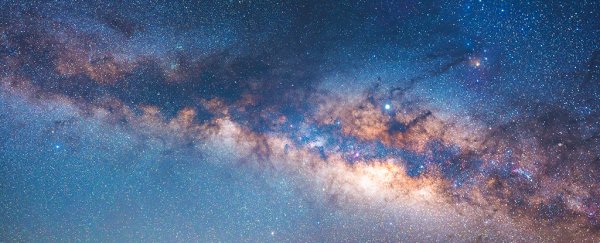There's alcohol up in space. No, it's not bottles of wine discarded by careless astronauts; rather, it's in microscopic molecular form. Now researchers think they've discovered the largest alcohol molecule in space yet, in the form of propanol.
Propanol molecules exist in two forms, or isomers, both of which have now been identified in observations: normal-propanol, which has been detected in a star-forming region for the first time, and iso-propanol (the key ingredient in hand sanitizer), which has never been seen in interstellar form before.
These discoveries should shed light on how celestial bodies such as comets and stars are formed.
"The detection of both isomers of propanol is uniquely powerful in determining the formation mechanism of each," says astrochemist Rob Garrod from the University of Virginia. "Because they resemble each other so much, they behave physically in very similar ways, meaning that the two molecules should be present in the same places at the same times."
"The only open question is the exact amounts that are present – this makes their interstellar ratio far more precise than would be the case for other pairs of molecules. It also means that the chemical network can be tuned much more carefully to determine the mechanisms by which they form."
These alcohol molecules have been found in what's known as a 'delivery room' of stars, the gigantic star-forming region called Sagittarius B2 (Sgr B2). The region sits near the center of the Milky Way and close to Sagittarius A* (Sgr A*), the supermassive black hole that our galaxy is built around.
While this kind of molecular analysis of deep space has been happening for more than 15 years, the arrival of the Atacama Large Millimeter/submillimeter Array (ALMA) telescope in Chile 10 years ago has stepped up the level of detail that astronomers can access.
ALMA offers a higher resolution and a greater level of sensitivity, enabling researchers to identify molecules that weren't visible before. Being able to pick apart the specific radiation frequency being emitted by each molecule in a busy part of space like Sgr B2 is crucial in calculating what's out there.
"The bigger the molecule, the more spectral lines at different frequencies it produces," says physicist Holger Müller from the University of Cologne in Germany. "In a source like Sgr B2, there are so many molecules contributing to the observed radiation that their spectra overlap and it is difficult to disentangle their fingerprints and identify them individually."
Thanks to the way that ALMA can detect very narrow spectral lines, as well as lab work that comprehensively characterized the signatures that propanol isomers would be giving off in space, the discovery was made.
Finding molecules that are closely linked – like normal-propanol and iso-propanol – and measuring how abundant they are relative to each other, enables scientists to look in more detail at the chemical reactions that have produced them.
The work continues to discover more interstellar molecules in Sgr B2, and to understand the sort of chemical melting pot that leads to star formation. The organic molecules iso-propyl cyanide, N-methylformamide, and urea have also been spotted by ALMA.
"There are still many unidentified spectral lines in the ALMA spectrum of Sgr B2 which means that still a lot of work is left to decipher its chemical composition," says astronomer Karl Menten from the Max Planck Institute for Radio Astronomy in Germany.
"In the near future, the expansion of the ALMA instrumentation down to lower frequencies will likely help us to reduce the spectral confusion even further and possibly allow the identification of additional organic molecules in this spectacular source."
The research has been published in Astronomy & Astrophysics here and here.
